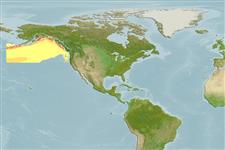>
Perciformes/Cottoidei (Sculpins) >
Liparidae (Snailfishes)
Etymology: Paraliparis: Greek, para = the side of + Greek, liparis = fat (Ref. 45335); bullacephalus: Named for its large, round head covered with gelatinous tissue; from Latin words 'bulla' meaning bubble and 'cephalus' for head.
Environment: milieu / climate zone / depth range / distribution range
Ecologia
marinhas batipelágico; intervalo de profundidade 233 - 322 m (Ref. 82595). Temperate
Gulf of Alaska.
Tamanho / Peso / Idade
Maturity: Lm ? range ? - ? cm
Max length : 6.2 cm SL macho/indeterminado; (Ref. 82595); 9.4 cm SL (female)
Descrição suscinta
Chaves de identificação | Morfologia | Morfometria
Raios dorsais (total) : 60; Raios anais : 53 - 55; Vértebras: 63 - 64. The species is distinguished from its congeners by the following set of characters: D 60; A 53-55; pectoral-fin rays 20-21; caudal-fin rays 6; vertebrae 63-64; dorsal contour of head rounded to snout, covered with gelatinous tissue; short snout with rounded tip projecting past upper jaw; small mouth, horizontal, inferior, with cleft reaching to nearly vertical below center of eye; large eye with dorsal margin level with or slightly above top of gill
opening; large opercular flap, rounded, projecting slightly toward dorsal; upper lobe of pectoral fin with 15 rays, one in
notch, and 4 or 5 in lower lobe, both lobes extending beyond anal-fin origin; cephalic pores are equal to or smaller in diameter than nostril; suprabranchial pore elevated, anterior of gill opening a distance about equal to opercular flap width; 3 pyloric caeca (Ref. 82595).
The male (5.30 and 6.20 cm) specimens appear to be mature, while the female (9.40 cm) was mature with ovaries containing numerous mature and immature, spherical, pale-colored, opaque, yolked oocytes, ranging in diameter from 0.20-2.12 mm; from gross observation, there appear to be fewer than 100 eggs in each ovary. Specimens were collected with a 60 cm bongo net, epibenthic sled and bottom trawl (Ref. 82595).
Ciclo de vida ou comportamento de acasalamento
Maturidade | Reprodução | Desova | Ovos | Fecundidade | Larvas
Busby, M.S. and R.L. Cartwright, 2009. Paraliparis adustus and Paraliparis bullacephalus: two new snailfish species (Teleostei: Liparidae) from Alaska. Ichthyol. Res. 56:245-252. (Ref. 82595)
Status na Lista Vermelha da UICN (Ref. 130435: Version 2024-1)
Ameaça para os humanos
Harmless
Uso pelos humanos
Pescarias: sem interesse
Ferramentas
Relatórios especiais
Baixar XML
Fontes da internet
Estimates based on models
Preferred temperature (Ref.
123201): 4.1 - 6.4, mean 5.1 °C (based on 9 cells).
Índice de diversidade filogenética (Ref.
82804): PD
50 = 0.5000 [Uniqueness, from 0.5 = low to 2.0 = high].
Bayesian length-weight: a=0.00525 (0.00237 - 0.01161), b=3.15 (2.96 - 3.34), in cm total length, based on LWR estimates for this (Sub)family-body shape (Ref.
93245).
Nível Trófico (Ref.
69278): 3.4 ±0.5 se; based on size and trophs of closest relatives
Resiliência (Ref.
120179): Elevada, tempo mínimo de duplicação da população menor que 15 meses (Preliminary K or Fecundity.).
Fishing Vulnerability (Ref.
59153): Low vulnerability (10 of 100).
